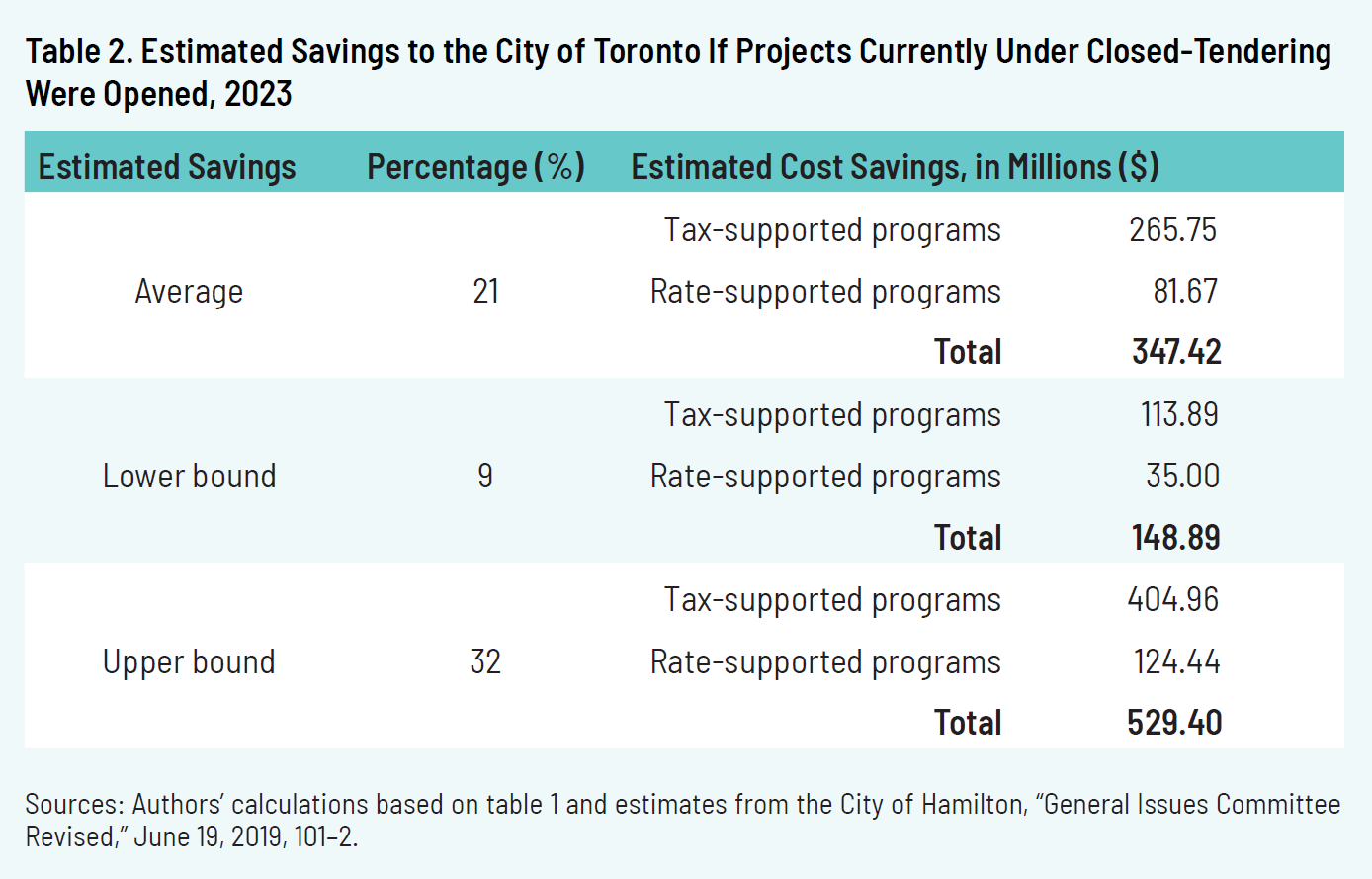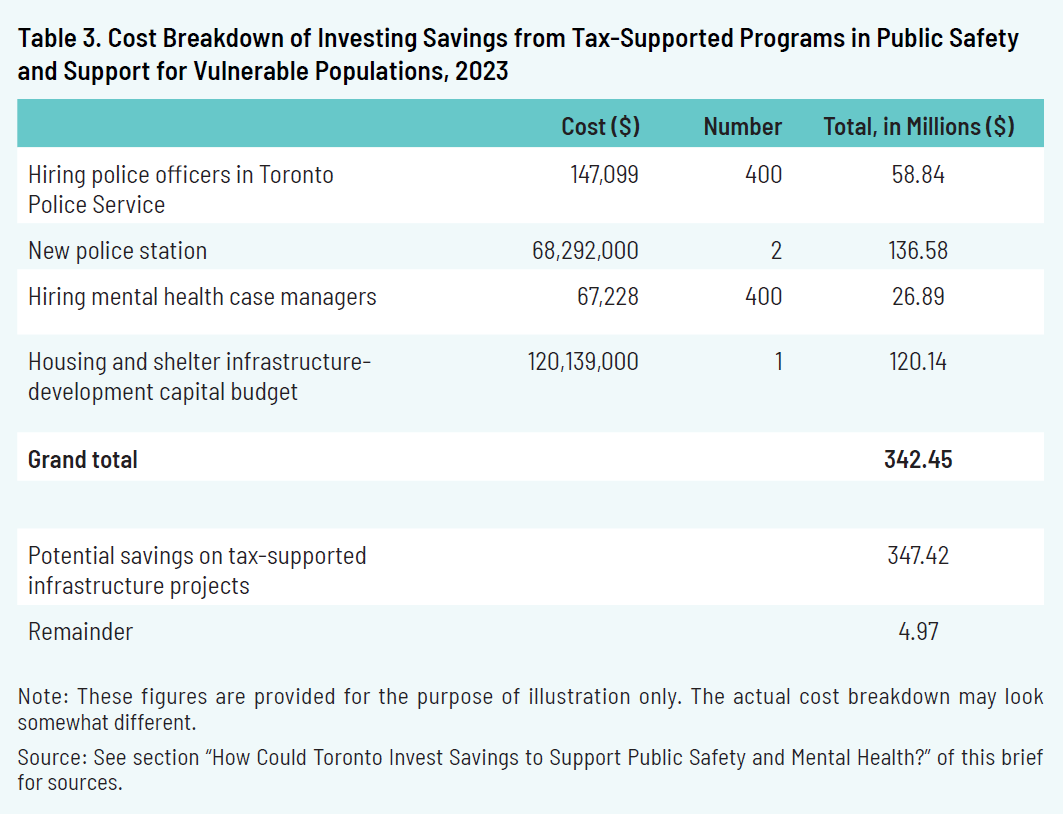Introduction
The City of Toronto is facing a severe budget crunch.
1
1
C. Fox, “Toronto Will Face $46.5 Billion in Financial Pressures over the Next Decade,” CTV News, March 21, 2023,
https://toronto.ctvnews.ca/toronto-will-face-46-5-billion-in-financial-pressures-over-the-next-decade-1.6322131.
At the same time, Torontonians are understandably demanding more action on issues such as safety on the TTC subway and the growing mental health crisis. With increasing stresses on municipal services, Toronto City Council will need to find creative ways and make better choices to address these concerns in the future.
One of these choices should be to implement a fair, open, and competitive tendering process for Toronto’s infrastructure construction.
Prior to 2019, municipal infrastructure procurement in some Ontario cities was restricted to firms whose workers belonged to certain building trade unions, functioning effectively as an oligopoly on procurement in these municipalities. Previous Cardus research has demonstrated that these restrictions led to significant decreases in competition for taxpayer-funded infrastructure projects and resulted in significantly higher costs for taxpayers in these cities. 2 2 See B. Dijkema, “Shortchanging Ontario’s Cities: A Cardus Competitiveness Monitor Update,” Cardus, 2018, https://www.cardus.ca/research/work-economics/reports/shortchanging-ontarios-cities/; B. Dijkema and M. Gunderson, “Restrictive Tendering: Protection for Whom?,” Cardus, 2017, https://www.cardus.ca/research/work-economics/reports/restrictivetendering-protection-for-whom/; M. Gunderson, T. Zhang, and B. Dijkema, “Up, Up, and Away: The Impact of Restrictive Tendering on Municipal Contracting in Ontario,” Cardus, 2017, https://www.cardus.ca/research/work-economics/reports/up-up-and-away/.
In 2019, the Ontario government passed Bill 66, known as the Restoring Ontario’s Competitiveness Act. 3 3 Restoring Ontario's Competitiveness Act, S.O. 2019, c. 4. This statute began as Bill 66, 1st Sess, 42nd Leg, Ontario, 2018. This bill amended the Labour Relations Act, 1995, to change the designation of municipalities, releasing them from the restrictive bargaining arrangements described above. At the same time, Bill 66 included a provision that gave municipal governments the option to choose to remain under the previous restrictive bargaining arrangements. In the wake of Bill 66, three municipalities, the City of Hamilton, the Region of Waterloo, and the City of Sault Ste. Marie, exercised their new rights to open-tendering practices to obtain significant savings in their procurement programs. 4 4 K. Howlett and J. Mahoney, “Toronto Votes to Continue Allowing Select Group of Labour Unions to Bid on Construction Projects,” Globe and Mail, June 19, 2019, https://www.theglobeandmail.com/canada/article-toronto-votes-to-continue-allowing-select-group-of-labour-unions-to/. An analysis of five specific cases by the City of Hamilton, for example, found that the potential savings arising from the change in law to open-tendering practices could amount to a 21 percent reduction, on average, in the cost of infrastructure projects. 5 5 City of Hamilton, “General Issues Committee Revised: Agenda Package,” June 19, 2019, 101–2, https://pub-hamilton.escribemeetings.com/FileStream.ashx?DocumentId=196165.
The City of Toronto chose to adhere to the previous bargaining arrangements, and as such, city construction in the industrial, commercial, and institutional (ICI) sector remains under closed-tendering rules. This choice meant that the city forwent the possibility of increased competition among construction firms for its infrastructure projects, which could have led to reductions in the price of these projects. These savings could then have been returned to taxpayers through tax reductions or reinvested in city services that need more money. The decision to retain the previous arrangements has therefore resulted in a loss of potential benefits to the taxpayer. 6 6 Howlett and Mahoney, “Toronto Votes to Continue.”
The purpose of this brief is to estimate the potential amount of taxpayer money that the City of Toronto could save by opening up infrastructure-tendering practices in the same way other Ontario cities have done. This brief provides an update to the 2018 Cardus study, “Shortchanging Ontario’s Cities,” using the most recent budget information from the City of Toronto and the City of Hamilton’s analysis on potential savings from opening its tendering practices. As in the 2018 study, we include the Toronto Community Housing Corporation which has similar closed-tendering rules for construction in the electrical, mechanical, and carpentry trades.
7
7
B. Dijkema, “Cardus Construction Competitiveness Monitor: Ontario Municipal Construction Markets,” Cardus, 2012,
https://www.cardus.ca/research/work-economics/reports/cardus-construction-competitiveness-monitor/.
This brief also considers alternative ways that the City of Toronto could use these funds for the benefit of taxpayers by addressing other critical municipal issues such as public safety on the city’s public-transit system.
How Much Construction Work is Subject to Closed Tendering?
We estimate that about $1.65 billion worth of infrastructure construction in Toronto is subject to closed-tendering provisions (table 1).
These figures were calculated from publicly available documents from the City of Toronto’s 2023 budget process. Each city department submits a budget note detailing its operating budget for the upcoming year and its ten-year capital plan. 8 8 Budget notes for each department can be found in the meeting minutes, which readers are encouraged to examine for themselves. It is important to note that not every city department had projects subject to closed-tendering provisions in its capital budget. Toronto City Council, “2023 Operating and Capital Budgets: Meeting Minutes,” City of Toronto, February 15, 2023, https://secure.toronto.ca/council/agenda-item.do?item=2023.MPB4.1. The budget notes include both tax-supported services— such as parks, homelessness supports, libraries, municipal child care centres, and emergency services— and the city’s three rate-supported services: water, solid waste, and parking. 9 9 The budget notes from the Toronto District School Board or the Toronto Transit Commission are not included our budget analysis because they have different labour obligations from the City of Toronto and handle their own procurement. The budget was approved by City Council on February 15, 2023. From these operating and capital plans, we compiled a list of infrastructure construction projects likely subjected to closed tendering, and their budgeted costs for 2023, taking into account any amendments made later in the budget process. 10 10 For a full list of our categorizations of the ICI sector within Toronto’s budget, please contact the authors.
Although it is difficult to estimate the full extent of projects subject to closed-tendering provisions based on limited information, we maintain that the numbers presented here are reasonable estimates of the data available to us. That said, it is worth noting that the City of Toronto estimated that it had spent $616 million in ICI construction in 2018. 11 11 Howlett and Mahoney, “Toronto Votes to Continue.” At the time, the city’s capital budget was $4.01 billion. 12 12 City of Toronto, “2018 City of Toronto Budget Summary,” 2018, 18, https://www.toronto.ca/ext/digital_comm/pdfs/finance/2018-toronto-budget-public-book.pdf. It grew to $4.45 billion in 2023, representing an increase of 11 percent over the last five years. 13 13 City of Toronto, “2023 Budget Launch Presentation,” January 10, 2023, 32, https://www.toronto.ca/legdocs/mmis/2023/bu/bgrd/backgroundfile-230875.pdf. Applying an 11 percent increase on the 2018 estimate for the city’s ICI construction would yield an estimate for 2023 of $684 million. Adding the 2023 capital budget for the Toronto Community Housing Commission, which is $350 million, 14 14 Toronto Community Housing Corporation, “Budget Notes: Toronto Community Housing Corporation and Toronto Seniors Housing Corporation,” City of Toronto, January 2023, https://www.toronto.ca/legdocs/mmis/2023/bu/bgrd/backgroundfile-231149.pdf. brings the approximation for the total amount subject to closed tendering to $1.03 billion. 15 15 Note that this may be a conservative estimate. The annual capital budgets tend to fluctuate from year to year. If we examine the ten-year capital plan, instead of the one-year capital budget, then the increase from 2018 to 2023 is a much larger number. In 2018, the ten-year capital plan was $39.8 billion (City of Toronto, “2018 City of Toronto Budget Summary,” 18). In 2023, it is $49.3 billion (City of Toronto, “2023 Budget Launch Presentation,” 32), representing a 24 percent increase. The true amount of construction subject to closed-tendering may therefore be larger than presented here. While this number is lower than our estimate above, we believe that our methodology used to calculate the earlier estimate is more precise than simply increasing the city’s 2018 estimate according to the growth of capital budgets. Regardless of which method is used, it is clear that the scope of construction work subject to closed tendering is almost certainly more than $1 billion.
How Much Could Toronto Taxpayers Save by Moving to Open Tendering?
We estimate that the City of Toronto could save about $347 million in 2023 if these construction projects were tendered in a manner consistent with the best practices that procurement experts recommend to achieve the best value for public expenditures (table 2). 17 17 For examples of these best practices, see B. Dijkema, “Shortchanging Ontario’s Cities”; Bauld and Dijkema, “Hiding in Plain Sight”; B. Dijkema, “Skimming Off the Top: How Closed Tendering Weakens Our Ability to Pursue the Public Good,” Cardus, 2018, https://www.cardus.ca/research/work-economics/reports/skimming-off-the-top/. There has been a wide range of estimated cost savings associated with open tendering proposed by various experts, municipalities, and organizations over the years. 18 18 For a range of some of these past estimates, see Dijkema, “Shortchanging Ontario’s Cities.” This paper uses a savings measure identified by the City of Hamilton in 2019 because it is the most recent government estimate we are aware of and the most directly analogous to what the City of Toronto could achieve. 19 19 City of Hamilton, “General Issues Committee Revised.” The City of Hamilton is a real-world example of a municipality that has moved from a closed-tendering regime to an open-tendering regime. Based on its own procurement history, the City of Hamilton found potential cost-savings ranging from 9 to 32 percent of the project cost, with average savings of 21 percent. While their sample size is small and may not translate precisely to the City of Toronto’s entire budget, the estimated cost savings nevertheless fall within the range of academic estimates and previous Cardus research.
Although we have attempted to be as careful and comprehensive as possible in our analysis, it is important to note that putting a dollar value on infrastructure spending that is currently subject to closed-tendering is difficult to determine for several reasons. The first is ambiguity surrounding the various construction sectors in Ontario. The Labour Relations Act identifies seven sectors of the construction industry, which are determined by work characteristics: ICI; residential; sewers and water mains; roads; heavy engineering; pipeline; and electrical power systems. 20 20 Labour Relations Act, S.O. 1995, c. 1, s 126(1), https://www.ontario.ca/laws/statute/95l01#BK159. As noted earlier, closed tendering currently applies only to ICI, the sector in which the City of Toronto has labour obligations to numerous building-trades unions, and to the electrical, mechanical, and carpentry work done through the Toronto Community Housing Corporation.
However, construction labour law and decisions made by the Ontario Labour Relations Board can be complex and as such, the case law that defines the scope of the ICI sector is continually evolving. The boundaries between sectors in the construction industry, then, are difficult to determine in practice. Moreover, the only information provided about many of these construction projects in the city’s budget is their names. While this information was generally sufficient to identify the projects that could be classified as ICI construction, some judgment was required in cases that were unclear. We aimed to be conservative in our estimates and sought to err on the side of excluding projects that we suspected might fall outside the ICI sector. 21 21 Cardus reached out to the City of Toronto to request their government data on the value of the city’s tendering in the ICI sector, but did not receive a response by the time of publication. We welcome more detailed data to provide a more precise estimate of the potential cost savings of open tendering.
Second, short of a detailed review of tender documents, it is impossible to determine the extent of Toronto’s closed-tendering regime with certainty. Tenders for individual projects may be partially or totally subject to closed-tendering rules. Moreover, projects that are outside the ICI sector and not legally subject to closed tendering are often treated as closed in practice. If the scope of a project is unclear, municipal procurement officials may prefer to adhere to closed tendering practices to avoid a potentially costly jurisdictional grievance from signatory unions. If anything, this ambiguity could expand the scope of the closed tendering policies in practice.
Third, procurement habits and culture may also contribute to the de facto closure of projects that might de jure have been tendered as open. This could include, for example, construction projects tendered by the Toronto Transit Commission, which are legally open but have an unclear status in practice. As we noted in an earlier paper, “High levels of government and bureaucratic discretion in determining which tenders are open, and which are subject to monopolies, provides further evidence in support of the notion that closed bidding increases rent-seeking activity from economic actors in the municipal construction market.” 22 22 B. Dijkema, “Cardus Construction Competitiveness Monitor,” 18.
How Could Toronto Invest Savings to Support Safety and Mental Health?
Our estimates suggest that the City of Toronto is unnecessarily spending hundreds of millions of taxpayers’ dollars every year by overpaying for its construction projects—a far cry from good stewardship of the taxes and fees collected from many Torontonians who are struggling with the rising cost of living. Fair and open tendering would mean that Toronto taxpayers would pay substantially less to obtain the same amount of infrastructure and could reap the benefits of cost-savings directed at addressing the city’s needs. How far might $347 million in anticipated annual savings go in Toronto? The potential savings on tax-supported infrastructure projects could go a long way toward helping the city address the pressing issue of public safety, especially in light of recent high-profile violent incidents in the city’s public-transit system that have sparked public discussion on how best to allocate municipal resources to improve public safety. With the savings gained from open tendering, the City of Toronto could make significant investments in both law enforcement and mental-health supports (table 3). 23 23 These figures are provided for the purpose of illustration only. The actual cost breakdown of expanding frontline supports would likely look somewhat different, since onboarding of new staff may involve more need for personnel management, which involves higher-salaried supervisors and physical office space.
With $347 million, Toronto could do all of the following simultaneously:
- Hire up to four hundred new police officers; 24 24 The City of Toronto estimates that the cost of a police officer is about $147,099, calculated from the estimated cost of $109 million for hiring 741 additional officers. See Toronto Police Service, “2023 Operating Budget Briefing Note—Police Officers Per Capita: Comparison to Other Jurisdictions,” City of Toronto, January 24, 2023, https://www.toronto.ca/legdocs/mmis/2023/bu/bgrd/backgroundfile-233973.pdf.
- Build up to two new police stations; 25 25 The budget for the new 41 Division facility is $68,292,000. See Toronto Police Service, “2023 Budget Notes: Toronto Police Service,” City of Toronto, January 2023, 25, https://www.toronto.ca/legdocs/mmis/2023/bu/bgrd/backgroundfile-231175.pdf.
- Fund up to four hundred new mental health case managers; 26 26 Our estimate of the annual wages of a mental-health case manager is $51,714, based on a wage rate of $26.52 per hour for 37.5 hours per week, 52 weeks per year. We then augment the wages by a factor of 1.3, Intuit’s mid-range estimate for the “true cost of a new employee,” for a total wage of $67,228. See QuickBooks Canada Team, “How to Calculate the True Cost of a New Employee,” QuickBooks Blog, December 1, 2022, https://quickbooks.intuit.com/ca/resources/manage-employees/how-to-calculate-the-true-cost-of-a-new-employee/. The wage rate was based on job postings from a charitable organization serving homeless and low-income people in Toronto. See Fred Victor Centre, “Housing Support Worker,” April 5, 2023, https://www.fredvictor.org/wp-content/uploads/2023/04/Housing-Support-Worker-HOP-2023-04.pdf; Fred Victor Centre, “Mental Health Case Manager,” April 5, 2023, https://www.fredvictor.org/wp-content/uploads/2023/04/HOP-MHCM-FT-Contract-2023-04.pdf; Fred Victor Centre, “Indigenous Mental Health Case Manager,” April 5, 2023, https://www.fredvictor.org/wp-content/uploads/2023/04/Indigenous-Mental-Health-Case-Manager-FT-Contract-2023-4.pdf. and
- Double its housing and shelter infrastructure-development capital budget (for emergency shelters, 24/7 warming centres, drop-in locations, and so forth). 27 27 The Shelter, Support, and Housing Administration’s 2023 capital budget for housing and infrastructure development is $120,139,000. See Shelter, Support and Housing Administration, “2023 Budget Notes: Shelter, Support and Housing Administration,” City of Toronto, January 2023, 27, https://www.toronto.ca/legdocs/mmis/2023/bu/bgrd/backgroundfile-231127.pdf.
The savings in tax-supported programs from open tendering could be maintained year-over-year and have a long-lasting impact in addressing taxpayers’ public safety concerns.
These are only a few examples intended to demonstrate the potential benefits that open tendering has for Toronto citizens. The savings could be directed in any number of ways, such as other spending priorities or lower taxes for Toronto residents.
If the city chose to change their tendering practices, Toronto would not be able to immediately access the full extent of these cost savings. Even if the city switched to competitive procurement overnight, it would take time for the capacity of the local construction industry to bounce back after operating under a restricted tendering system for decades. But as these examples show, the potential benefits of an open market are enormous, especially for Toronto taxpayers.
Conclusion
Municipal governments are facing significant fiscal pressures, including demands for greater focus on safety and mental health. In an era of increasingly scarce resources, governments must become more efficient with taxpayer dollars. The amount of money that the City of Toronto leaves on the table due to restrictive closed-tendering policies ought to be a matter of significant concern for taxpayers and their representatives on Toronto City Council.
Although it is difficult to estimate the potential cost-savings of open-tendering practices, we maintain that our calculations are reasonable estimates based on the information available to us at the time of writing. While we endeavoured to be conservative in our analysis, it is possible that some of our estimates may be too high or too low.
However, even if the number of Toronto’s closed-tendering projects was on the lower end of reasonable estimates, the city would still have over $1 billion worth of public construction work that is currently insulated from open, competitive bidding. Either way, the city would still be forgoing hundreds of millions of dollars that could be used to improve safety and mental health.
As previous Cardus research and other sources have discovered, the City of Toronto’s decision to use restrictive tendering practices has resulted in substantial economic, social, and industry costs for Toronto taxpayers. For how long will taxpayers bear the costs of restrictive-tendering practices when there are better choices for Toronto?




